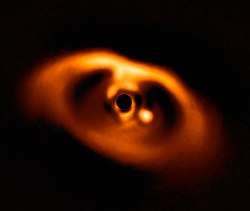Contribution to ARIEL Spectroscopy of Exoplanets
Contribution to ARIEL Spectroscopy of Exoplanets (CASE) is an infrared spectrometer instrument for the planned European ARIEL space telescope. It is being developed by NASA as a contribution to the European Space Agency (ESA) project to add scientific capabilities to the space telescope to observe the chemical composition of the atmospheres of exoplanets,[1] as well exoplanetary metallicities.[1][2] The ARIEL spacecraft with CASE on board is planned to launch in 2028.
Overview
ARIEL will be able to study the chemical "fingerprints", or spectra of an exoplanet's atmosphere as the light of its host star passes through the exoplanetplanet's atmosphere. The and the addition of CASE, will allow to observe clouds and hazes, which help establish planetary climate, and provide a more comprehensive picture of the exoplanet atmospheres ARIEL observes.[2]
The CASE instrument consists of two detectors and associated electronics that are sensitive to light at near-infrared (NIR) wavelengths as well as visible light.[1] The detectors and its associated electronics are the same that NASA is contributing to ESA's Euclid mission,[1] being a mosaic of 4×4 Teledyne H2RG detectors sensitive to near-infrared light radiation (1.0-2.0 μm) with 65 million pixels.[3] CASE will be a subsystem of ARIEL's FGS instrument,[2] which is an infrared spectrometer that operates in two channels (0.50-1.2 μm photometry; 1.25-1.95 μm spectroscopy).[2][4]
CASE is an astrophysics Mission of Opportunity by the Explorers Program. The Principal Investigator of CASE is Mark Swain, at the Jet Propulsion Laboratory (JPL).[1] The ARIEL spacecraft with CASE on board is planned to launch in 2028.[1][5]
See also
References
- NASA Instrument to Probe Planet Clouds on European Mission. Elizabeth Landau, NASA News. 8 November 2019.
- "Constraining Exoplanet Metallicities and Aerosols with ARIEL: An Independent Study by the Contribution to ARIEL Spectroscopy of Exoplanets (CASE) Team." Robert T. Zellem, Mark R. Swain, Nicolas B. Cowan, etal. arXiv; submitted on 6 Jun 2019. doi:10.1088/1538-3873/ab2d54.
- "Euclid Spacecraft Payload". ESA. Retrieved 29 January 2011.
- ARIEL - Payload. ESA. 20 March 2018.
- Science & Technology Portal staff (20 March 2018). "ESA's next science mission to focus on nature of exoplanets". ESA Science & Technology Portal. European Space Agency. Archived from the original on 22 March 2018. Retrieved 22 March 2018.

